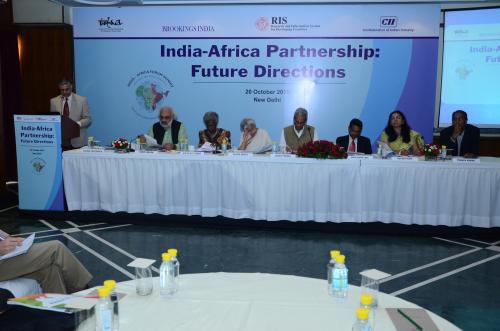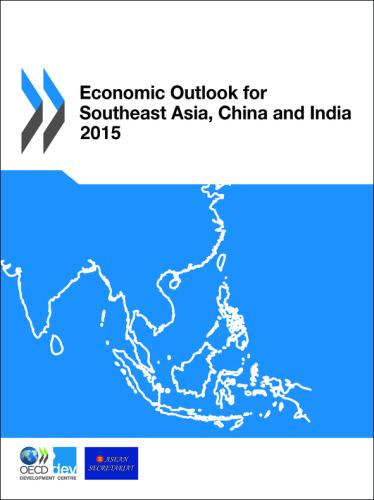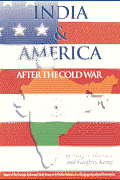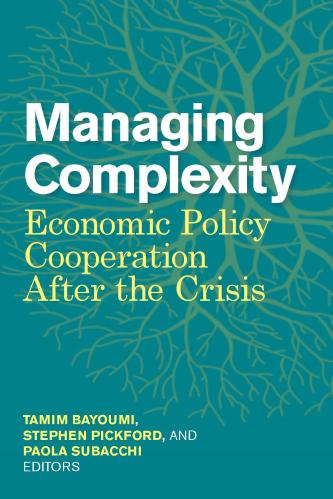Content from the Brookings Institution India Center is now archived. After seven years of an impactful partnership, as of September 11, 2020, Brookings India is now the Centre for Social and Economic Progress, an independent public policy institution based in India.
This article first appeared in India and Africa: Forging a Strategic Partnership’, a briefing book published by Brookings India in October 2015. Like other products of the Brookings Institution India Center, this is intended to contribute to discussion and stimulate debate on important issues. The views are those of the author.
The same article was featured in The Economic Times, 29th October 2015.
By Sachin Chaturvedi
The approach for the way forward is to ensure equal commitment from both sides
Over the years, India’s engagement with Africa has evolved across five different modalities bringing in trade and investment, capacity building, technology transfer, grants and concessional finance, and finally, lines of credit (LOCs). All these five modalities provide a major pull for wider engagement across the global south in general and Africa in particular. Since these engagements have happened through the Indian missions based in different countries, the wider process may be called as the ‘mission approach’ and the mechanism for this is the ‘development compact’, which, in real terms means a development partnership for cohesive and comprehensive engagement. Trade and Investment: India was one of the first few countries, after the Hong Kong World Trade Organization (WTO) Ministerial in 2005, that announced duty free, quota free access to low income countries. This scheme was announced in 2008 and became fully operational in 2012. India also took measures for supporting trade finance related initiatives.
Even during the recession period in 2009-2012, trade between India and Africa grew by nearly 32 per cent annually and India-Africa trade is projected to reach $90 billion by 2015. In addition, India has also signed bilateral trade agreements with more than 20 African countries. Indian private investment in Africa has also surged over a period of time with major investments in telecommunications, IT, energy, and automobile sectors.
Capacity Building: India has also established scholarships to foster cultural and educational relations with Africa. There is an increasing focus on three main components: providing training in India, sending teams of experts to partner countries and providing equipment for project sites. Support for capacity building in Africa is continuing; India has also taken up larger issues at various multilateral forums including the WTO and the World Intellectual Property Organization. The multiplicity of fellowships and training programmes in turn has led to the rejuvenation of India’s civilian training programmes, viz., Indian Technical & Economic Cooperation Programme (ITEC) and Special Commonwealth Assistance for Africa Programme (SCAAP) to offer help to developing countries in Africa.
Sharing Technology and Know-how: Indian engineers have played a crucial role in development projects in terms of implementation and creating capacity. For instance, in Ethiopia 12 engineers provided support and training in areas such as irrigation, electrical power and railway management. India helped establish a residential Royal Technical College in Nairobi in 1956 to provide higher technical, commercial and arts education bearing a cost of $1.5 million.
Line of Credit: Of India’s global total of $11.63 billion, New Delhi provided $6.74 billion lines of credits to Africa alone, which was 57.93 percent of the total during the period 2006 to April 2015. Moreover, several Indian science and technology projects have also been reinforced through other modalities. For instance, India provided $13.2 million for establishing solar panel production unit outside Maputo in Mozambique. This included not only a line of credit, but also included training for scientists and some grant elements for supporting travel, etc. However, distinguishing projects on the lines of modalities alone would not always be possible. In fact, this reinforces the idea of ‘development compact’, whereby multiple modalities ensure a certain movement towards comprehensive development. Even the deputing of manpower has a spillover effect and this is more so in the areas where engineering or health sector is involved.
Sectoral Support: India and Africa have had a long-term and fruitful partnership in development cooperation in the field of health. India has been a source for reliable and quality medicines and vaccines at affordable rates for large parts of Africa.
Tele-medicine has been another major initiative launched by India. The cooperation has also extended to other areas of health care, such as development of infrastructure, like hospitals, and building up local capacity in drug production through the setting up of joint ventures. India and Africa have also been major trade partners in pharmaceuticals. In light of the new United Nations Sustainable Development Goals, the cooperation between the two parties in the field of health care and pharmaceuticals needs to be further intensified and carried forward with greater vigour.
In the last two summits, India committed itself to providing greater support for institution building; but there is a need to revisit some of the proposals. The approach for the way forward is to ensure equal commitment from both sides before proposals are finalised. India should share details of its own institutions and the experiences of its own development journey. The cooperation would crucially depend on building resilience of institutions particularly for impact assessment and evaluation.
Dr. Sachin Chaturvedi, Director General, Research and Information System for Developing Countries







Commentary
Op-edEqual commitment from India and Africa is the only way forward
October 29, 2015